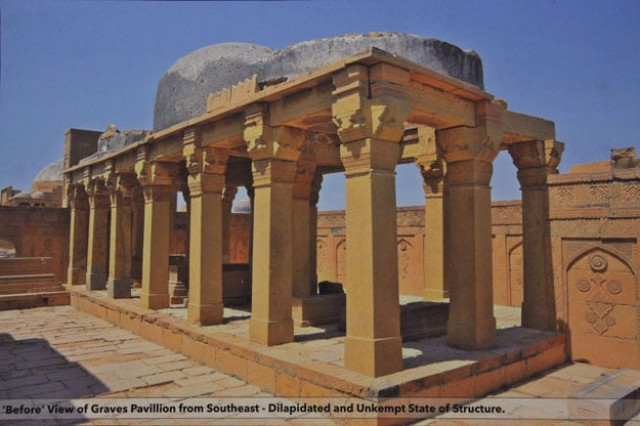
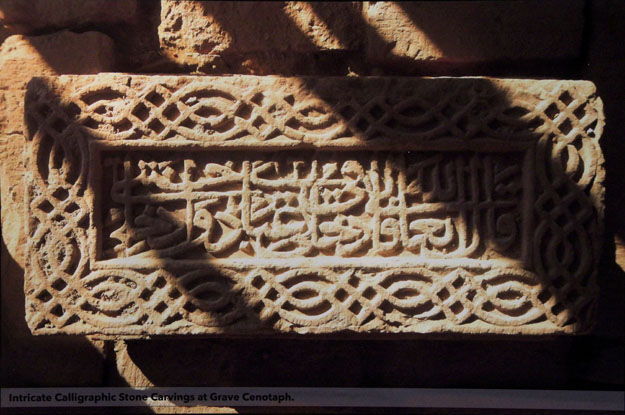 Titled ‘Restoring Cultural Heritage to its Past Grandeur’, the exhibition provided a look into the grandeur of Makli’s heritage. PHOTO: AYESHA MIR/EXPRES
Titled ‘Restoring Cultural Heritage to its Past Grandeur’, the exhibition provided a look into the grandeur of Makli’s heritage. PHOTO: AYESHA MIR/EXPRESHeritage Foundation CEO Yasmeen Lari told The Express Tribune about how they have tried to rebuild the tomb of Mirza Jan Baba, where domes had collapsed. "Makli is a world heritage, considered to be the largest Muslim necropolis,” she said. She added that they tried to save everything in the best possible manner, sensitively touching the original place. “We wanted to give it [a new look] with dignity and not completely transform it."
Mirza Jan Baba's entire family was killed by his close relative, Mirza Baqi, in a family feud that revolved around power struggle.
 On display were many images, including the fuel-efficient double stove as well as the glazed ceramics being practised by the village women. PHOTO: AYESHA MIR/EXPRESS
On display were many images, including the fuel-efficient double stove as well as the glazed ceramics being practised by the village women. PHOTO: AYESHA MIR/EXPRESSYasmeen was speaking at the opening of an exhibition at Fomma DHA Art Centre located within the premises of Zamzama Park. Titled ‘Restoring Cultural Heritage to its Past Grandeur’, the exhibition provided a look into the grandeur of Makli’s heritage. On display were many images, including the fuel-efficient double stove as well as the glazed ceramic art being practised by the village women.
Yasmeen, an architect, with the support of her husband, Suhail Lari, who is a historian, has been able to rebuild the mehraab [opening], entrance and canopy of the tomb as well as a couple of domes that had been destroyed at Makli. Yasmeen was able to get foreign funding from the German Consulate based in Karachi.
Preserving heritage: Songs of Pamir ring at Lok Virsa
"It was in 1966, when as a small child of 10 years, I watched on German television a documentary film on [the] Makli necropolis, which has a thousand graves in it,” said Rainer Schmiedchen, the consul-general of Germany in Karachi. “I read all about it [later] in an encyclopaedia. Decades later, my dream came true as I visited this place with Yasmeen Lari giving us a guided tour.”
 The German consul-general was of the view that preservation starts with the protection of the monument site, where, he suggested, fencing will be needed. PHOTO: AYESHA MIR/EXPRESS
The German consul-general was of the view that preservation starts with the protection of the monument site, where, he suggested, fencing will be needed. PHOTO: AYESHA MIR/EXPRESSHe was of the view that preservation starts with the protection of the monument site, where, he suggested, fencing will be needed. “There is also the danger of natural disasters, particularly flooding, as River Indus is not far away,” he said. “For this purpose, [the] German foreign ministry and the German consulate based in Karachi have funded and supported the conservation project carried out by Yasmeen Lari for the years 2015 and 2016 with 85,000 Euros.”
This exhibition continues till March 25 in the evening hours at the gallery.
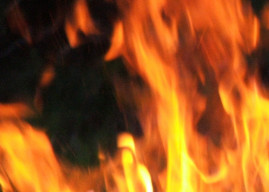


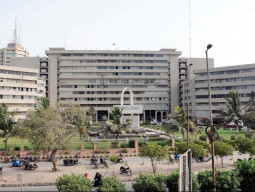
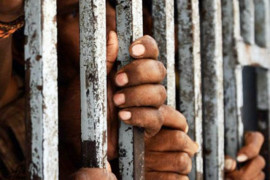













COMMENTS
Comments are moderated and generally will be posted if they are on-topic and not abusive.
For more information, please see our Comments FAQ